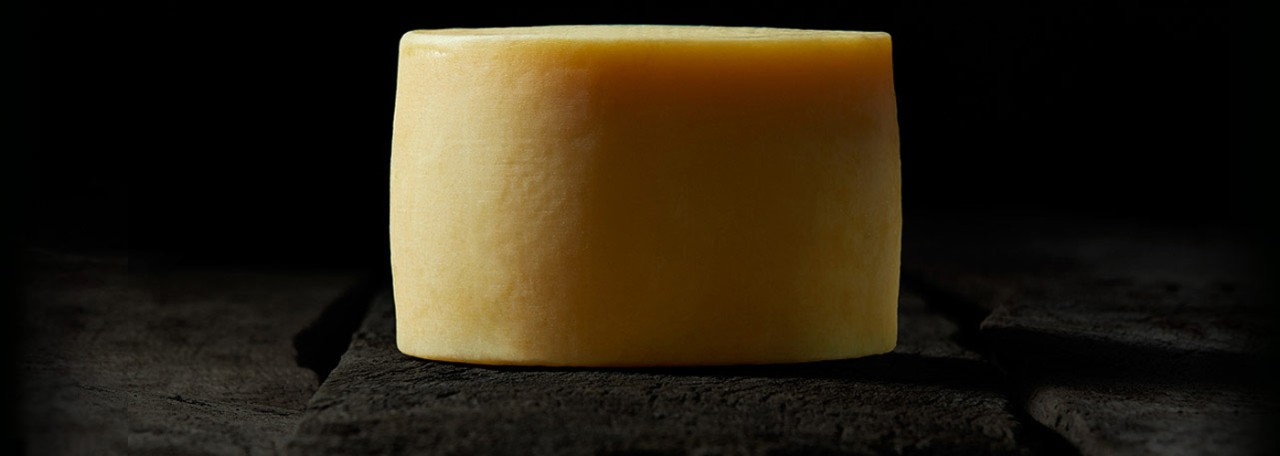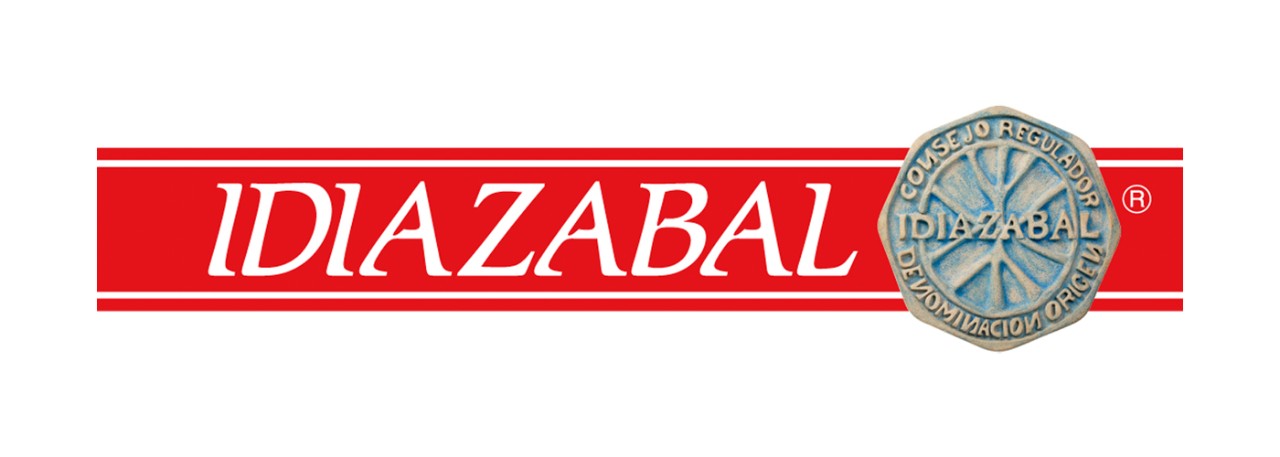.png.transform/rendition-xs/image_image%20(1).png)
Idiazabal PDO
Pressed, hard cheese made from whole, raw ewes’ milk from the Latxa and Carranzana breeds, with a minimum ripening period of 60 days.
Tasting notes
A penetrating, clean aroma, reminiscent of ripe ewes’ milk. Depending on the time of year, the milk production area, the techniques used and the ripening period, the aroma has different degrees of piquancy, acidity and sweetness. In smoked cheeses, the smokiness in the paste should not be too pronounced.
The flavor is intense, full and balanced. Its clean consistency, with a marked taste of ripened ewes’ milk and a hint of the natural rennet are characteristic. The piquancy is slight, the sweetness and acidity are very slight to medium. There is no bitterness, the saltiness is of medium intensity and the smoky flavor is light to medium in smoked cheeses. A prolonged, pronounced aftertaste follows.
The cheese is compact, with medium elasticity and fairly firm. Grains can be detected when the cheese is chewed but it is not lumpy. Moisture is lost during ripening so, the longer this takes, the less elastic, more crumbly and harder the cheese becomes.
Other notes
The shape is even and regular, cylindrical, with flat top and bottom. The sides are slightly convex and the corners rounded in small cheeses and sharp in large cheeses. The height is 8-12 cm (3-4.7”), the diameter 10-30cm (4-12”) and the weight 1-3 kgs (2 lb 3 oz - 6 lb 10 oz).
The rind is hard and smooth, and may bear the markings of the cloths used during processing and, on one side, there may be very light markings from the tray the cheeses are laid on during ripening. The rind in the natural variety is yellowish beige if it has been briskly brushed with water, or whitish grey if the brushing was gentler and dry. In smoked cheeses, the color is brownish ocher or tan. Before smoking, the cheeses must be carefully washed.
The paste is compact and may have a few, irregularly-distributed, uneven holes smaller than a grain of rice. The even, matt color varies with time from ivory to straw yellow. The cheese usually has a narrow, slightly dark strip at the edge, which is brownish in smoked cheeses. This strip becomes broader and darker with ripening and is usually larger in larger cheeses.
The end product has the following physical and chemical properties:
- Fat over dry matter: 45 % minimum.
- pH: from 4.9 to 5.5
- Dry matter: 55% minimum.
- Total protein over dry matter: 25 % minimum.
Production / Processing method
The sheep ewes must be fed in the traditional way, grazing directly on the best pastures the production area has to offer.
The milk must be whole and clean, without any preservatives, with a good balance between proteins and fats, and without any colostrum or medications that might have a negative effect on the production, ripening and preservation of the cheese, and on its hygiene conditions.
The ewes must be milked with care and the milk kept below 10ºC (50ºF). The pure ewes’ milk, without any prior processing, is gently heated in stainless steel vats to 30ºC (86ºF). The exact dose of animal rennet and other enzymes authorized by the Regulatory Council are then added to bring about coagulation in 20-45 minutes, depending on the acidity of the milk and time of the year. A temperature of 28-32ºC (82-89ºF) must be maintained throughout. The rennet, from milk-fed lamb, is first cleaned, then dried, crushed and mixed with salt.
The resulting curds are repeatedly cut until they reach the size of maize corn or rice grains, 5-10 mm in diameter (0.2-0.4”). The mixture is then stirred for about 15 minutes and usually re-heated at 36-38ºC (96.8-100.4ºF) for 25 minutes.
To make it easier to drain off the whey, the curds are stirred slowly while the temperature of the vat is raised to about 37ºC (98ºF). This makes it possible to retain only the nutritional substances of the milk, its fat and proteins. When the cheese-maker considers the grains have become sufficiently hard, the heating stops and they are allowed to fall to the bottom of the vat, covered with the whey.
After removing the whey, the curds are molded in cylinders to form the characteristic wheel shape. Each cheese is marked with a number to guarantee traceability. Pressing takes place in mechanical, usually pneumatic presses, at 1½ - 4 atmospheres, for 5-6 hours.
The cheeses are then turned out and salted with dry salt or in saturated brine, at a temperature of 8-13ºC (46-55ºF). The duration of submersion in brine varies between 24 hours for small cheeses and 48 hours for large ones. The airing process depends on the cheese-maker but is never more than 30 days, at 10-13ºC (50-55ºF) and 80% relative humidity.
Ripening must last at least 60 days as from the date of molding. It is carried out at 8-10ºC (46-50ºC) at relative humidity of 85-90%. The cheeses remain on trays and are turned and cleaned periodically, as required, so that they gain their special characteristics.
Throughout the process, the acidity of the cheese rises, helping to improve its keeping qualities. Ripening lasts a minimum of two months although, to bring out the best in the cheese, a period of four to eight months is preferable, depending on personal taste.
The cheese may be smoked using beech or alder wood, a few days before sale. The PDO products are identified with a numbered label issued and controlled by the Regulatory Council.
Geography / Relief and climate
This is mountainous territory, with peaks reaching about 1,500 m (4,921 ft) and irregular terrain. There are two main areas – the Basque mountains, which are the continuation of the Pyrenees, and the Ebro depression to the south. Most of the territory stems from the Cretaceous period, with strips of the Paleogene in Navarre and the provinces of Vizcaya and Álava in the Basque Country, and a Carboniferous nucleus between the provinces of Guipúzcoa and Navarre to the north of the Aralar mountains.
The materials are limestone, limestone-sandstone, marl, sandy marl and clay. These sedimentary rocks have developed on the surface to create soils that can be classified as moist limey brown with pH of 7-7½. These are excellent for pastures. In addition to their standard qualities, the cheeses made from milk from ewes grazing on the Urbasa and Andía mountains are said to be sweeter as the soils there are chalkier, whereas the more acid soils of the Aralar mountains give more piquant cheeses.
The traditional method of land use is for grazing to take place from November to April. The grass is cut in the second half of July, then again in August, to make hay. The sheep then return to graze in autumn. The province of Vizcaya has the largest grazing lands.
The topographical features give rise to climatic variety – from the Atlantic climate in the provinces of Vizcaya and Guipúzcoa and the northern valleys in the province of Álava and north-west of Navarre, to the Mediterranean climate inland in the Rioja Alavesa and Ribera Navarra. The latter two areas have few sheep. The Atlantic climate brings rainfall in excess of 1,200 mm (47”) and average temperatures of 13-14ºC (55-57ºF). The average maximum is 16-18ºC (61-64.4ºF) and the average minimum 9-10ºC (48-50ºF).
The river network is large and rich, because of the complex relief and heavy rainfall. There are two watersheds – the Cantabrian, which collects the water from Vizcaya, Guipúzcoa and the valleys in the north of Álava and Navarre, and the Mediterranean, which covers Álava, Middle Navarre and La Ribera. The rivers in the Cantabrian basin are short and fast-flowing and include the Bidasoa, Oria, Deba, Urola, lbaizábal, Nervión, Cadagua and Urumea. Those on the Mediterranean side are tributaries of the Ebro and include the Zadorra and Bayas in Álava and the Ega, Arga and Aragón in Navarre.
Regulatory Council
Consejo Regulador de la DOP Idiazabal
Granja Modelo de Arkaute, s/n
01192 Arkaute (Alava)
Navarra
Tel: (+34) 945 289 971
info@idiazabalgazta.eus
www.quesoidiazabal.eus / www.idiazabalgazta.eus
Sources:
- Spanish Ministry of Agriculture
The cheese may be smoked using beech or alder wood, a few days before sale.


- Idiazabal 1
- Idiazabal 2

Arkaute (Basque Country and Navarre)
